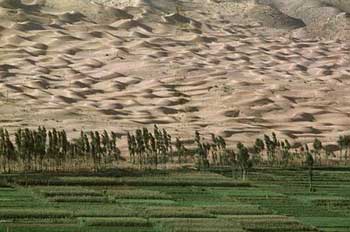 |
| The
desert encroaching onto fertile planting fields, about
100 kilometers west of Yin Chuan, capital of Ningxia
Hui Autonomous Region, in northwest China in this
July 31, 1996 file photo. China has lost 92,100 square
kilometers (36,000 square miles), an area the size
of Portugal, to desert, since the 1950s.(AP Photo/MaxVision) |
UNITED NATIONS (AP) - The world is turning
to dust, with lands the size of Rhode Island becoming
desert wasteland every year and the problem threatening
to send millions of people fleeing to greener countries,
the United Nations says.
One-third of the Earth's surface is at
risk, driving people into cities and destroying agriculture
in vast swaths of Africa. Thirty-one percent of Spain
is threatened, while China has lost 36,000 square miles
to desert - an area the size of Indiana - since the 1950s.
This week the United Nations marks the
10th anniversary of the Convention to Combat Desertification,
a plan aimed at stopping the phenomenon. Despite the efforts,
the trend seems to be picking up speed - doubling its
pace since the 1970s.
"It's a creeping catastrophe,"
said Michel Smitall, a spokesman for the U.N. secretariat
that oversees the 1994 accord. "Entire parts of the
world might become uninhabitable."
Slash-and-burn agriculture, sloppy conservation,
overtaxed water supplies and soaring populations are mostly
to blame. But global warming is taking its toll, too.
The United Nations is holding a ceremony
in Bonn, Germany, on Thursday to mark World Day to Combat
Desertification, and will hold a meeting in Brazil this
month to take stock of the problem.
The warning comes as a controversial movie,
"The Day After Tomorrow" is whipping up interest
in climate change, and as rivers and lakes dry up in the
American West, giving Americans a taste of what's to come
elsewhere.
The United Nations says:
-- From the mid-1990s to 2000, 1,374 square
miles have turned into deserts each year - an area about
the size of Rhode Island. That's up from 840 square miles
in the 1980s, and 624 square miles during the 1970s.
-- By 2025, two-thirds of arable land
in Africa will disappear, along with one-third of Asia's
and one-fifth of South America's.
-- Some 135 million people - equivalent
to the populations of France and Germany combined - are
at risk of being displaced.
Most at risk are dry regions on the edges
of deserts - places like sub-Saharan Africa or the Gobi
Desert in China, where people are already struggling to
eke out a living from the land.
As populations expand, those regions have
become more stressed. Trees are cut for firewood, grasslands
are overgrazed, fields are over-farmed and lose their
nutrients, water becomes scarcer and dirtier.
Technology can make the problem worse.
In parts of Australia, irrigation systems are pumping
up salty water and slowly poisoning farms. In Saudi Arabia,
herdsmen can use water trucks instead of taking their
animals from oasis to oasis - but by staying in one place,
the herds are getting bigger and eating all the grass.
In Spain, Portugal, Italy and Greece,
coastal resorts are swallowing up water that once moistened
the wilderness. Many farmers in those countries still
flood their fields instead of using more miserly "drip
irrigation," and the resulting shortages are slowly
baking the life out of the land.
The result is a patchy "rash"
of dead areas, rather than an easy-to-see expansion of
existing deserts, scientists say. These areas have their
good times and bad times as the weather changes. But in
general, they are getting bigger and worse-off.
"It's not as dramatic as a flood
or a big disaster like an earthquake," said Richard
Thomas of the International Center for Agricultural Research
in the Dry Areas in Aleppo, Syria. "There are some
bright spots and hot spots. But overall, there is a trend
toward increasing degradation."
The trend is speeding up, but it has been
going on for centuries, scientists say. Fossilized pollen
and seeds, along with ancient tools like grinding stones,
show that much of the Middle East, the Mediterranean and
North Africa were once green. The Sahara itself was a
savanna, and rock paintings show giraffes, elephants and
cows once lived there.
Global warming contributes to the problem,
making many dry areas drier, scientists say. In the last
century, average temperatures have risen over 1 degree
Fahrenheit worldwide, according to the U.S. Global Change
Research Program.
As for the American Southwest, it is too
early to tell whether its six-year drought could turn
to something more permanent. But scientists note that
reservoir levels are dropping as cities like Phoenix and
Las Vegas expand.
"In some respects you may have greener
vegetation showing up in people's yards, but you may be
using water that was destined for the natural environment,"
said Stuart Marsh of the University of Arizona's Office
of Arid Lands Studies. "That might have an effect
on the biodiversity surrounding that city."
The Global Change Research Program says
global warming could eventually make the Southwest wetter
- but it will also cause more extreme weather, meaning
harsher droughts that could kill vegetation. Now, the
Southwest drought has become so severe that even the sagebrush
is dying.
"The lack of water and the overuse
of water, that is going to be a threat to the United States,"
Thomas said. "In other parts of the world, the problem
is poverty that causes people to overuse the land. Most
of these ecological systems have tipping points, and once
you go past them, things go downhill."
|